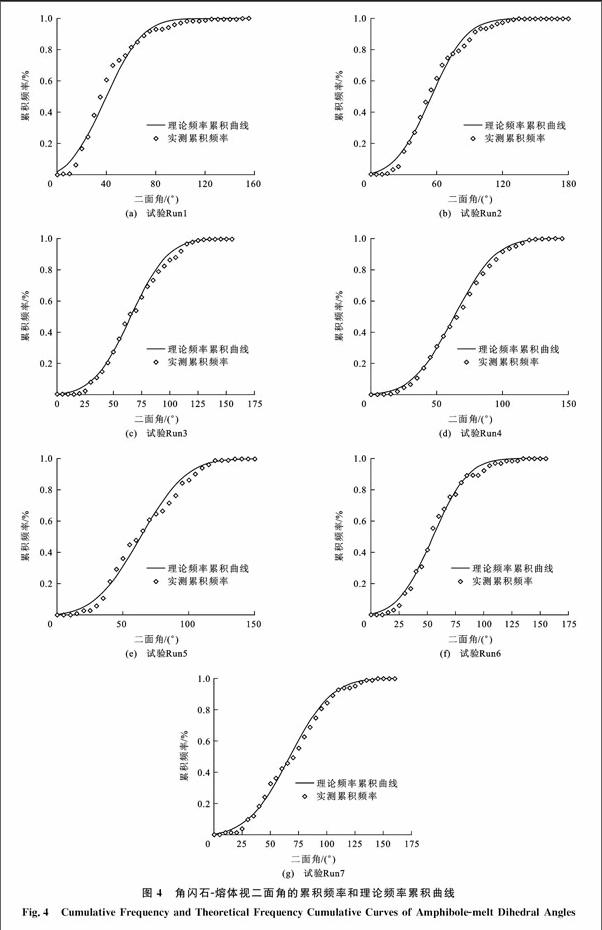粗面玄武岩熔融—结晶过程中角闪石—熔体二面角:温度和压力的影响
2016-06-30赵东宇张波胡贤旭范大伟周文戈谢
赵东宇+张波+胡贤旭+范大伟+周文戈+谢鸿森



摘要:矿物-熔体二面角是了解岩浆岩结构演化和岩浆动力学的重要参数。为了研究温度和压力对矿物-熔体二面角的影响,以粗面玄武岩为初始样品,在压力为0.6~2.6 GPa,温度为800 ℃~900 ℃,恒温100 h的条件下分别对初始样品进行了温度和压力两个系列的熔融-结晶试验。温度系列试验(3组)条件为:恒定压力为0.6 GPa,首先在温度为1 350 ℃的条件下恒温1 h,使粗面玄武岩完全熔融,然后改变温度使粗面玄武岩熔体分别在温度为800 ℃、850 ℃和900 ℃以及恒温100 h的条件下结晶。压力系列试验(4组)条件为:分别在压力和温度为0.6 GPa、1 350 ℃,1.1 GPa、1 375 ℃,1.6 GPa、1 400 ℃,2.1 GPa、1 425 ℃和2.6 GPa、1 450 ℃条件下恒温1 h,使粗面玄武岩完全熔融,然后降温至900 ℃,恒温100 h使粗面玄武岩熔体结晶。在上述试验条件下,粗面玄武岩熔体主要结晶相为角闪石。采用在二维任意切面测定二面角的方法得到试验产物中的角闪石-熔体二面角。将试验获得的角闪石-熔体视二面角的累积频率与理论频率累积曲线进行对比,并讨论了温度和压力对二面角的影响。角闪石-熔体视二面角中值随着温度的升高而增加。这主要是由于在高温条件下,角闪石的成核密度小,生长速度快,有利于角闪石晶体的生长粗化,大的颗粒相互接触拼接形成高角度二面角,而在低温条件下,角闪石的成核密度大,生长速度慢,不利于角闪石晶体的粗化,角闪石的矿物颗粒较小且近平行排列,从而形成低角度二面角。另外,角闪石-熔体视二面角中值随着压力的升高先升高再降低,最后升高,这可能是熔体和矿物之间显著的力学性质差异造成的。试验结果证明,在岩浆结晶作用早期,随着矿物由孤立状态向拼接结构发展,矿物-熔体二面角逐渐增大。同时,将本次试验结果与前人关于岩浆结晶晚期矿物(或矿物-熔体)二面角的演化规律相结合,可以描绘出整个岩浆结晶过程中矿物-熔体二面角的变化规律。
关键词:二面角;熔融-结晶;粗面玄武岩;高温高压;界面能;拼接结构;结构平衡;岩浆结构演化
中图分类号:P589.1;P586 文献标志码:A
Abstract: The mineral-melt dihedral angle is a very important parameter to further understand the crystallization kinetics and the textural evolution of magma. Using trachybasalt as the starting material, two series of melt-crystallization experiments (temperature series and pressure series) were conducted at the pressures of 06-26 GPa, the temperatures of 800 ℃-900 ℃ and the annealing time of 100 h, to investigate the influence of temperature and pressure on the mineral-melt dihedral angle. In the temperature series (3 groups), trachybasalt were fused at the temperature of 1 350 ℃, the pressure of 0.6 GPa and the annealing time of 1 h, to obtain homogeneous melts; then, the melting temperatures dropped to the crystallization temperatures of 800 ℃, 850 ℃ and 900 ℃, and annealed for 100 h. In the pressure series(4 groups), the trachybasalt were fused at the temperatures and pressures of 1 350 ℃ and 06 GPa, 1 375 ℃ and 1.1 GPa, 1 400 ℃ and 1.6 GPa, 1 425 ℃ and 2.1 GPa, and 1 450 ℃ and 26 GPa, respectively; the samples were kept under such conditions for 1 h to ensure completely melting and proper homogeneity, and then the temperatures dropped to the crystallization temperature of 900 ℃ and annealed for 100 h. Amphibole was the main crystal phase in the process of trachybasalt crystallization under the above experimental conditions. The amphibole-melt dihedral angles from the experimental products were obtained by measuring the dihedral angles in the two-dimensional random sections. The effects of temperature and pressure on the dihedral angle were discussed by comparing the observed cumulative frequency of the amphibole-melt dihedral angles in the run products with the theoretical cumulative frequency curve. The median of apparent dihedral angles in amphibole-melt increases with the increase of temperature. The nucleation density of amphibole is small while the growth rate is fast at high temperature; thus, the higher temperature is beneficial to the growth and coarsening of amphibole, so that the grains impinge and form the high dihedral angle. Conversely, the nucleation density of amphibole is large while the growth rate is slow at low temperature; therefore, the low temperature impedes the growth and coarsening of amphibole, and results in the parallel grains with the small dihedral angle. Moreover, the median of amphibole-melt apparent dihedral angles increases initially, then reduces and finally increases again with the growing pressure, the possible reason is the prominent difference in mechanical properties between the melt and minerals. It is proved that the mineral-melt dihedral angle gradually increases with the development of mineral from isolation to impingement texture in the early stage of magma crystallization. Furthermore, combined the result of this study with the previous work about the evolution of mineral (or mineral-melt) dihedral angle in the late stage of magma crystallization, the evolution trend for the mineral-melt dihedral angle in the whole process of magma crystallization can be inferred.
